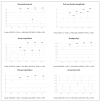Four-Year Training Course for Police Officers (CFOP) and Fitness Outcomes of Police Academy Cadets: A Cohort Study from 2004 to 2020
- PMID: 37958045
- PMCID: PMC10650632
- DOI: 10.3390/healthcare11212901
Four-Year Training Course for Police Officers (CFOP) and Fitness Outcomes of Police Academy Cadets: A Cohort Study from 2004 to 2020
Abstract
This study examines the effect of gender, age, and a 4-year training course for police officers (CFOP) on the physical fitness attributes of Portuguese police academy cadets. This longitudinal cohort study considered 686 police cadets (female, n = 131; male, n = 555 male), corresponding to 2578 fitness assessments (female, n = 509; male, n = 2069). The database of police cadets' physical fitness evaluations (from 2004/2005 to 2019/2020) comprises body size, speed, agility, strength, flexibility, and aerobic capacity first assessment (T0) and evaluations at the end of the first four years of the CFOP (T1, T2, T3, T4). Results showed that (i) female cadets are younger (p < 0.05), shorter, lighter, less fast, less agile, less strong, and perform worse in aerobic capacity assessments than male cadets (all, p < 0.001) but perform better in the flexibility assessment (p < 0.001); (ii) female cadets > 29 years are significantly heavier, slower, jump less, perform fewer sit-ups, and perform less on the Cooper test (but they have more handgrip strength), and male cadets > 29 years are significantly heavier, slower, jump less, perform fewer sit-ups, and have less flexibility and aerobic capacity (still, they have superior back and lumbar strength and handgrip strength); and (iii) from T0 to T4 (Δ), female cadets are significantly faster (60 m, -0.32 s; slalom, -0.78 s), jump further (+4 cm), have more abdominal strength endurance (+2.6 repetitions) and more back and lumbar strength (+89.8 kg), and male cadets are significantly heavier (+3.27 kg), faster (60 m, -0.23 s; 30 m, -0.15 s; slalom, -0.91 s), jump further (+8 cm), complete more repetitions in the sit-ups (+4.9 repetitions) and in pull-ups (+2.5 repetitions) and have more back and lumbar strength (+92.1 kg) and handgrip strength (+8.6 kg) but a lower aerobic capacity (Cooper test, -74.8 m; VO2max, -1.3 mL/kg/min) when compared to T0. The study's findings lead to widely accepted conclusions within the discipline. Nevertheless, this work provides valuable insights into the impact of various factors on the physical fitness of Portuguese police academy cadets, i.e.: (i) it is an essential study with practical implications for recruitment, training, and the ongoing development of Portuguese police academy cadets and police officers; and (ii) these results can also assist in tailoring training programs to different age groups and genders, which is crucial in police training.
Keywords: aerobic capacity; age; gender; normative data; police academy; speed; strength.
Conflict of interest statement
The authors declare no conflict of interest.
Figures




 , female;
, female;  , male; T0, initial assessment; T1, first year; T2, second year; T3, third year; T4, fourth year; statistics (difference from T0)—***, p < 0.001 or **, p < 0.01 or *, p < 0.05.
, male; T0, initial assessment; T1, first year; T2, second year; T3, third year; T4, fourth year; statistics (difference from T0)—***, p < 0.001 or **, p < 0.01 or *, p < 0.05.
 , female;
, female;  , male; T0, initial assessment; T1, first year; T2, second year; T3, third year; T4, fourth year; Statistics (difference from T0)—***, p < 0.001 or **, p < 0.01.
, male; T0, initial assessment; T1, first year; T2, second year; T3, third year; T4, fourth year; Statistics (difference from T0)—***, p < 0.001 or **, p < 0.01.Similar articles
-
Fitness Profile of Police Officers from Rapid Intervention Teams of the Lisbon Metropolitan Command.J Funct Morphol Kinesiol. 2025 Mar 11;10(1):90. doi: 10.3390/jfmk10010090. J Funct Morphol Kinesiol. 2025. PMID: 40137342 Free PMC article.
-
The Use of 2 Conditioning Programs and the Fitness Characteristics of Police Academy Cadets.J Athl Train. 2016 Nov;51(11):887-896. doi: 10.4085/1062-6050-51.8.06. Epub 2016 Nov 18. J Athl Train. 2016. PMID: 27863188 Free PMC article.
-
Assessing Differences in Anthropometric and Fitness Characteristics Between Police Academy Cadets and Incumbent Officers.J Strength Cond Res. 2018 Sep;32(9):2632-2641. doi: 10.1519/JSC.0000000000002328. J Strength Cond Res. 2018. PMID: 29120983
-
Characterization of the Physical Fitness of Police Officers: A Systematic Review.J Strength Cond Res. 2019 Oct;33(10):2860-2874. doi: 10.1519/JSC.0000000000003177. J Strength Cond Res. 2019. PMID: 31045682
-
Identifying the Physical Fitness and Health Evaluations for Police Officers: Brief Systematic Review with an Emphasis on the Portuguese Research.Biology (Basel). 2022 Jul 15;11(7):1061. doi: 10.3390/biology11071061. Biology (Basel). 2022. PMID: 36101439 Free PMC article. Review.
Cited by
-
Effects of Specific RAMP Protocol Phase on Change of Direction Speed of Police Students.J Funct Morphol Kinesiol. 2024 Oct 13;9(4):194. doi: 10.3390/jfmk9040194. J Funct Morphol Kinesiol. 2024. PMID: 39449488 Free PMC article.
References
-
- Kukić F., Jeknic V., Dawes J., Orr R.M., Stojkovic M., Čvorović A. Effects of training and a semester break on physical fitness of police trainees. Kinesiology. 2019;51:161–169. doi: 10.26582/k.51.2.2. - DOI
-
- Orr R., Wilson A., Pope R., Hinton B. Profiling the routine tasks of police officers; Proceedings of the ASCA National Conference on Applied Strength and Conditioning; Melbourne, Australia. 4–6 November 2016.
LinkOut - more resources
Full Text Sources

